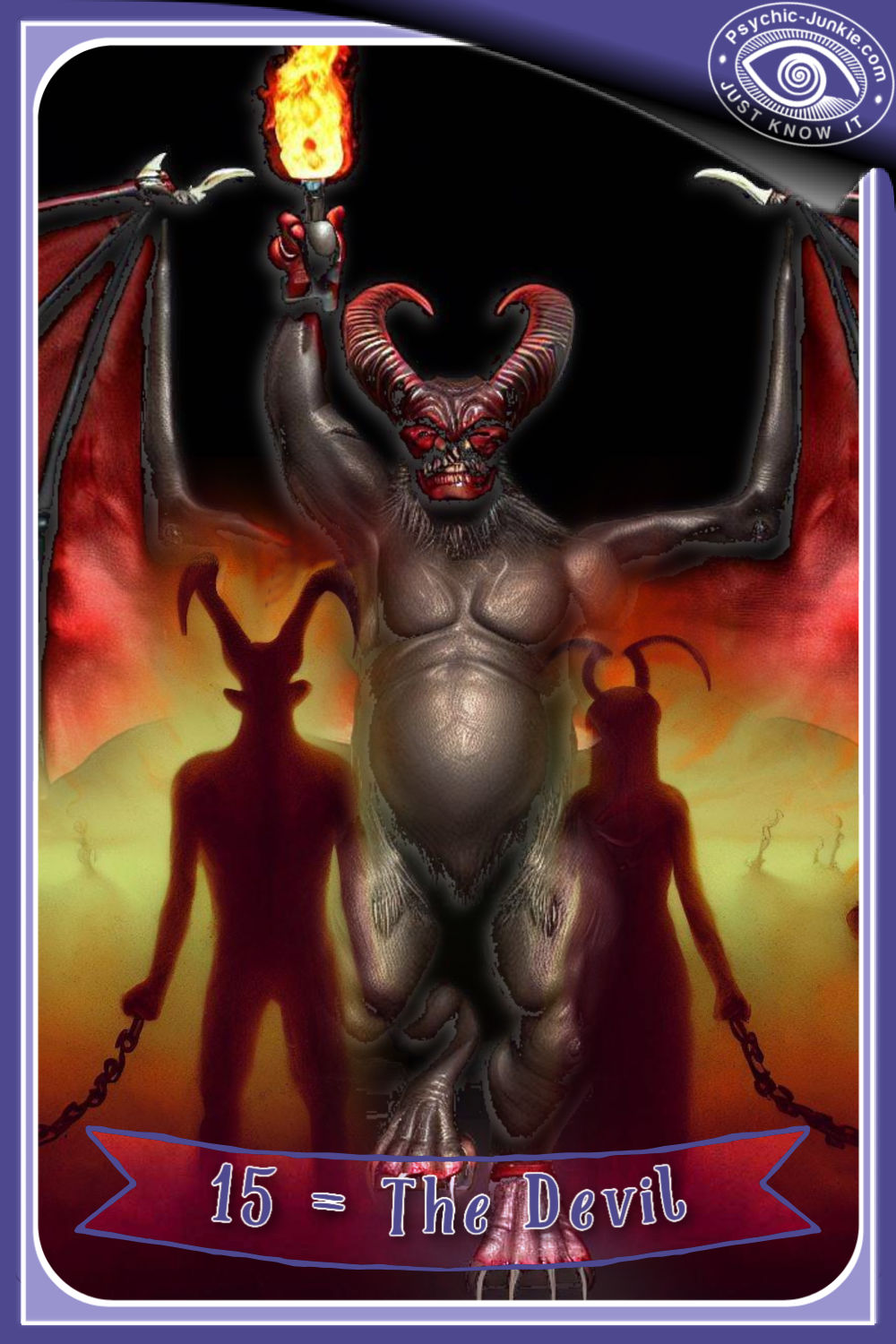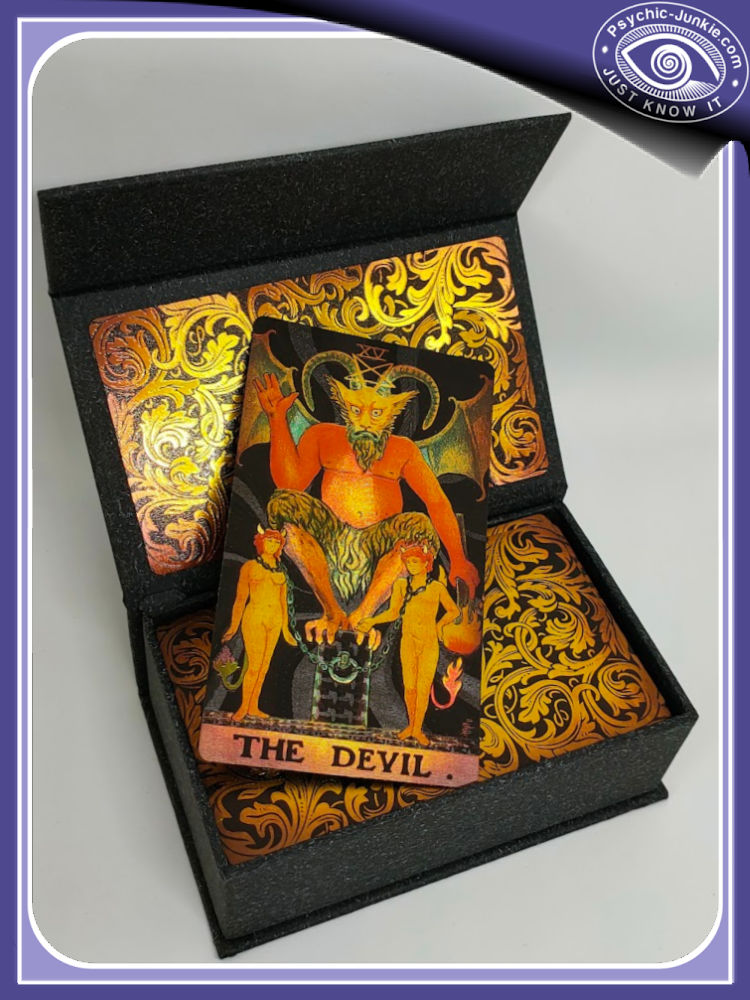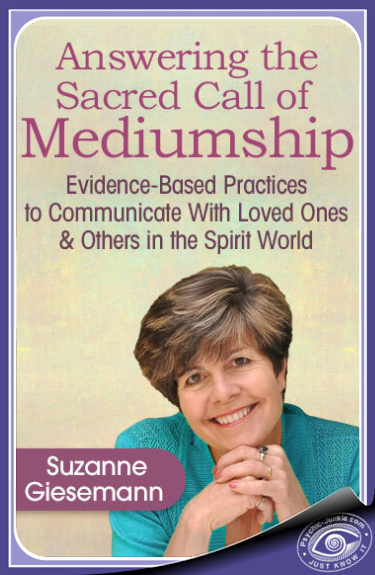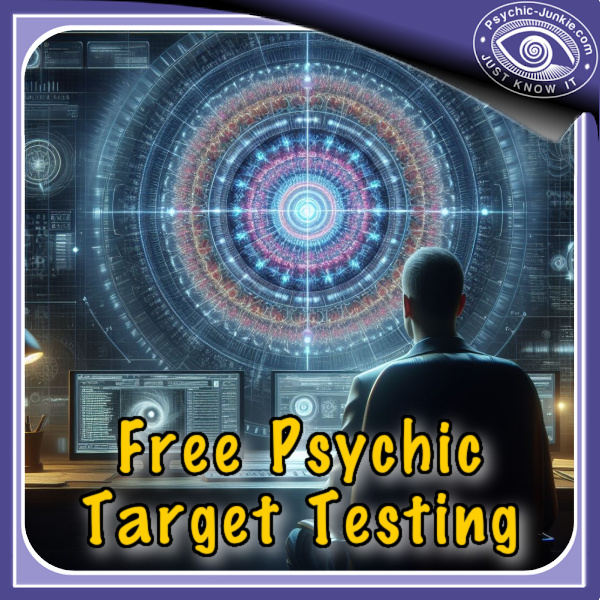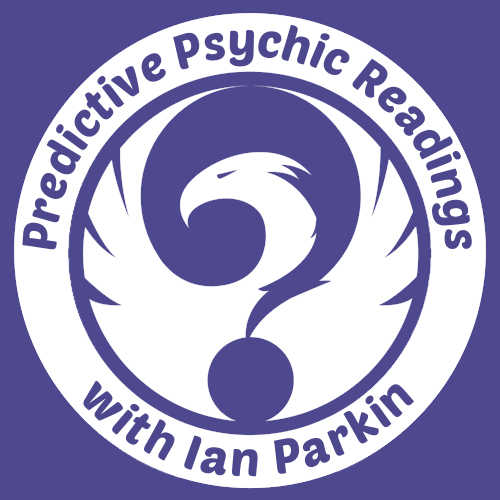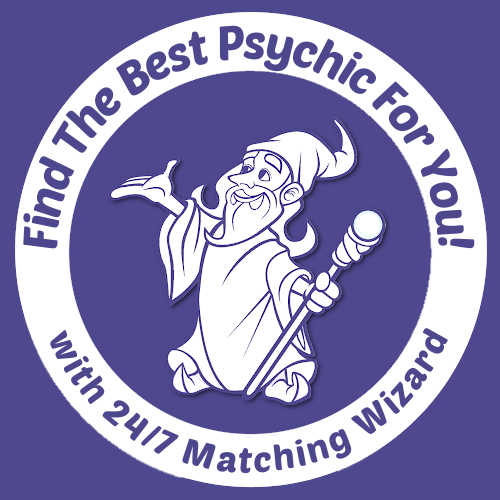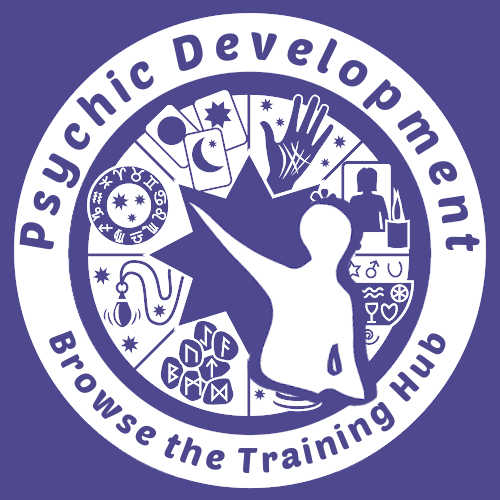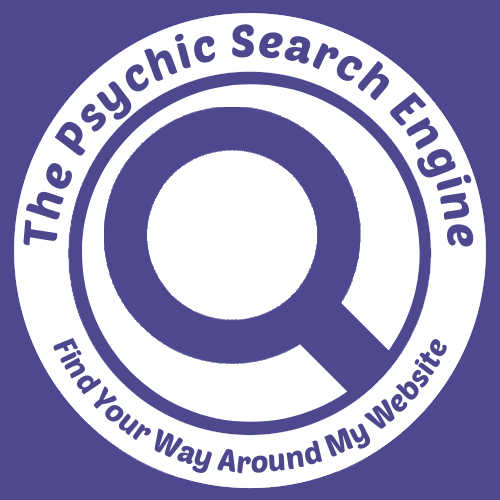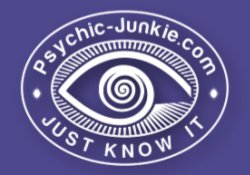- Home
- All Tarot Cards
- The Devil Tarot Card
Ian Parkin is the author of this post.
The Devil Tarot Card Takes Us On A Journey Through Our Shadow Side
The Devil tarot card is like a dark knight, leading us to confront our deepest fears and desires. It's not the most comfortable journey, but it's one that paves the way for growth, transformation, and self-acceptance.
There's no denying that the Devil tarot card can stir up quite a storm of anxiety. Its ominous name and somber image may seem daunting at first glance. But this card offers a transformative lens for examining personal shadows and offers a stepping stone towards liberation. It is the proverbial thorn in the side that pushes us to rise above our self-imposed limitations.
In the tarot's sacred art, lies a card that plays its part, "The Devil Tarot Card," they say, "A symbol dark to light the way."
Fear not the horns or chains you see, they are but mirrors of the "me," A shadow side that seeks the light, to turn our wrongs into the right.
The Devil, no, he's not to blame, just a guide in life's strange game, A wake-up call, a stark invite, to face our fears and take flight.
For in the heart's courageous leap, are secrets we're destined to keep, Lessons learned and love reclaimed, the Devil card is not so famed.
It teaches us to break the ties, to rise, to fall, to harmonize, So take a breath and look inside, with the Devil tarot as your guide.
In every dark, a light awaits, in every love, a fear abates, The Devil card, misunderstood, is but a journey to the good.
Key Aspects About The Devil Tarot Card.
Symbolism: The Devil tarot card usually features the Devil himself, often depicted as a satyr-like creature that's half human, half animal. The card traditionally shows the Devil holding a torch while two chained figures, often a man and a woman, are trapped below him. This image represents themes of bondage, addiction, materialism, negativity, and being trapped.
Main Themes: The Devil card's main themes include enslavement to physical or material desires, ignorance, hopelessness, restriction, and self-destructive behavior. It symbolizes a situation where you feel trapped or bound, often because of your own negative habits or attachments.
Meaning in Readings: In a reading, if the Devil card appears, it is often a sign to take a hard look at your life and identify anything that you have become too attached to. It could be a destructive habit, an obsession, or a toxic relationship. It suggests you may be giving up your personal power to these substances, people, or situations. It is a call for self-examination and the release of negative energy. However, it's important to note that The Devil card isn't always a negative card. It can also symbolize our primal instincts and the raw, natural desires that drive us. It could encourage you to take a walk on the wild side, explore your desires and break free from social norms and expectations.
Numerology: The Devil is the 15th card of the Tarot, and the number 15 can be reduced to the number 6 (1+5) in numerology, which symbolizes balance, harmony, and cooperation. However, in the case of the Devil card, it suggests an imbalance or excessive focus on material or sensual pleasures, which can lead to a lack of harmony and cooperation.
Astrology: In astrology, the Devil card is associated with the sign Capricorn. Capricorn, an Earth sign, is practical, disciplined, and ambitious, but it can also be pessimistic and holding back due to its focus on structure and tradition. This connection suggests the struggle to break free from societal or self-imposed constraints and to follow one's own path.
Archetype: The Devil card represents the archetype of the Shadow Self, the part of ourselves that we deny or ignore because it does not align with our idealized self-image. It often reflects our base desires and drives that are viewed as socially inappropriate or unacceptable, but it can also be a powerful source of transformative energy if we confront and integrate these aspects of our personality.
Finding More Meaning In The Devil Tarot Card
Symbolic Meanings
When we think about the traditional Rider-Waite-Smith depiction of the Devil tarot card, images of a horned beast, shackled figures, and an ominous backdrop often spring to mind. The card's rather eerie aesthetic does more than just keep you on your toes – it offers rich symbolism that dives deep into the human psyche. The chains signify the self-imposed bindings and habits that often restrict us, while the Devil is the embodiment of our suppressed desires and fears.
However, don't take my word as gospel. The tarot is like a chameleon, changing colors across different traditions. In the Thoth Tarot, the Devil takes the form of Pan, the Greek god of nature, spontaneity, and primal desire, reinforcing the theme of unchecked impulses and instincts. On the other hand, in the Tarot Of Marseille, the Devil is a more cartoonish figure, inviting the notion of misguided actions and life's ironies.
The Devil's Numerology in the Tarot
Let's not overlook the Devil's number – 15. In numerology, 15 boils down to 6 (1+5), a number resonating with harmony, love, and the balance of opposites. Seems a bit wonky, right? A love-dovey number for a card that's a bit on the sinister side? But that's the thing about the Devil card – it's about finding balance amid temptation, achieving harmony by recognizing and addressing our shadows.
Upright and Reversed Meanings
In its upright position, the Devil tarot card serves as a wake-up call. It's like a chill running down your spine, forcing you to address your shadow side, addiction, and unhealthy attachments. It's the catalyst that incites you to break free from your self-imposed chains.
But when the Devil rears its head in a reversed position, it's a sign of liberation, a proverbial pat on the back for breaking free from your shackles and embracing personal transformation. It's the dawn after the dark night of the soul, a symbol of self-awareness and rebirth.
The Devil Tarot Card in Real Life
Applying the Devil tarot card to real-life scenarios can be a bit of a rollercoaster. In terms of career, the Devil can represent feeling chained to a job or struggling with workaholic tendencies. Love-wise, it might denote an obsessive relationship, or a situation where passion overrules reason. In the realm of personal development, it often symbolizes a necessary confrontation with your shadow self to achieve growth.
Tracing the Devil’s Footsteps: The Historical Context
The origins of the Devil tarot card can be traced back to the 15th century, where it often signified mischief and misfortune. However, as the tarot has evolved, so too has the Devil's symbolism. Rather than being a harbinger of doom, the Devil tarot card has come to represent the shadows within us that need acknowledgement and integration for personal growth and self-discovery.
FAQs about the Tarot's Devil Card
What does the Devil card represent in a Tarot reading?
What does the Devil card represent in a Tarot reading?
- The Devil card in Tarot typically symbolizes materialism, addiction, bondage, ignorance, and lust. It might point to a situation where you feel trapped or restricted, possibly due to unhealthy habits or relationships. However, it also serves as a reminder that you have the power to break free from these chains. The Devil can also represent a strong, sometimes blind, attachment to material possessions and earthly pleasures.
Is the Devil card a negative card in Tarot?
Is the Devil card a negative card in Tarot?
- The Devil card is often seen as negative because it can indicate feeling trapped, experiencing excessive attachment, or engaging in self-destructive behaviors. However, like all Tarot cards, it isn't inherently good or bad. Its meaning depends on the context of the question asked and its position in the reading. It can also be a powerful wake-up call, signaling the need for self-awareness and transformation.
What does the Devil card mean in a love or relationship reading?
What does the Devil card mean in a love or relationship reading?
- In a love or relationship reading, the Devil card can represent unhealthy dynamics such as codependency, manipulation, or obsessiveness. It may point to relationships that are based more on physical attraction rather than emotional or spiritual connection. Alternatively, it can suggest the need to confront and deal with issues, or to release toxic bonds.
What does it mean when the Devil card is reversed?
What does it mean when the Devil card is reversed?
- When reversed, the Devil card can indicate breaking free from bonds, overcoming addiction, or resisting temptation. It suggests a realization and acknowledgment of unhealthy patterns, relationships, or behaviors, and taking steps to change them. It can also symbolize personal growth, liberation, and detachment from materialism.
How should I interpret the Devil card in the context of a career reading?
How should I interpret the Devil card in the context of a career reading?
- In a career reading, the Devil card might suggest you feel trapped in your current job or that you're overly fixated on financial gain. It can also refer to unethical business practices or colleagues who may be negatively influencing you. Alternatively, it can simply mean dedication and a strong focus on career advancement, although with a warning not to neglect other aspects of life. The card encourages balance and calls for a review of your professional relationships and practices.
Meanings For Each Element Of The Devil Tarot Card
The Rider-Waite version of The Devil tarot card, illustrated by Pamela Colman Smith under the direction of Arthur Edward Waite, is filled with symbolic elements. Here's a description of each:
The Devil: The Devil himself is central to the card, symbolizing bondage, temptation, ignorance, and materialism. He represents our base desires and can also represent feeling out of control or ensnared in situations that are unhealthy or harmful.
Horns: The Devil has horns, which are traditionally associated with the idea of the 'horned god' of many pagan religions, symbolizing fertility and the earth. Here, they indicate the Devil's raw, primal nature.
Bat Wings: The Devil is depicted with bat wings, symbolizing the realm of night, illusions, and instinctual, reactionary actions, as opposed to thoughtful and conscious choices.
Inverted Pentagram: The inverted pentagram on the Devil's forehead symbolizes the inversion of spiritual consciousness. Instead of spirit being in control, the physical senses and desires have taken over.
Torch: The Devil holds a torch, but unlike the illuminating light of conscious awareness, his torch is used to burn and destroy, representing a destructive force.
Man and Woman: In front of the Devil are a man and woman, chained but appearing relatively content. They represent humans trapped in the material, earthly realm, beholden to their base desires and passions.
Chains: The chains around the necks of the man and woman are loose enough to be removed, suggesting that the bondage is self-imposed. They symbolize addiction, unhealthy relationships, or other situations where one feels trapped but could, in reality, free oneself with enough will and determination.
Fruits on the Tail: The tail of the woman is often described as bearing fruits, symbolizing the temptation and false promises that lead people into harmful situations.
Bare Mountainous Landscape: The barren, rocky background suggests a harsh, desolate environment. It can represent a sense of hopelessness or the feeling of being stuck in a difficult, unyielding situation.
Remember, interpretation of Tarot cards can vary greatly depending on the context of the question asked, and the connection between the reader and the querent. The Devil, while often seen as a negative card, can also remind us of the importance of self-awareness and introspection in overcoming our personal "demons" or challenges.
Develop Your Intuition And Become An Online Tarot Card Reader
You can learn how to become a professional online tarot card reader in 90 days or less with Tatiana Jones' bestselling course. In this short course, Titania teaches everything you need to know to start an online tarot reading business - with zero experience required! You do not need to be psychic to read tarot cards online! It is all about being intuitive and “connecting the dots”.
Tarot Reading Entrepreneurship
- Help People Find Meaning
- Work Remotely
- Set Your Own Hours
- Replace Your Full Time Income
- Work Just A Few Hours Per Day
Learn To Be A Psychic Medium
An Evidence-Based Path to Communicate With Loved Ones & Others in the Spirit World.
In this FREE hour with Suzanne Giesemann, you will: Gain an understanding of “evidential” mediumship and why it’s so sacred. Discover the 3 keys to mediumship: Belief in the Spirit World, alignment, and a shift in focus from the physical to the Spirit World. Learn how you can begin communicating with your loved ones who have passed. Find mediumship can be a path for your soul’s evolution. Hear about what makes a reading “evidence-based” - and how this form of mediumship raises the bar and meets the true goal of being an authentic and indisputable voice for Spirit. Experience a practice to connect with your guides and ask them for signs. Click here to learn more about this free event > >
Test Your Psychic Ability
The Lifeleap Institute’s Psychic Project is a unique online psychic development tool using real people and events as "psychic targets."
They start by asking you to focus on the "psychic targets" and answer a series of special questions about these targets.
They then reveal to you the actual psychic targets. You get to compare your results with the actual psychic targets. You also get to see the results of other participants.
Even if you think you have no psychic ability, this tool will offer proof that you do.
It's easy to participate and the Psychic Project is free!
Click Here To Test Your Psychic Ability
Develop Your Intuition And Become An Online Tarot Card Reader
You can learn how to become a professional online tarot card reader in 90 days or less with Tatiana Jones' bestselling course.
In this short course, Titania teaches everything you need to know to start an online tarot reading business - with zero experience required!
You do not need to be psychic to read tarot cards online! It is all about being intuitive and “connecting the dots”.
Tarot Reading Entrepreneurship
- Help People Find Meaning
- Work Remotely
- Set Your Own Hours
- Replace Your Full Time Income
- Work Just A Few Hours Per Day
- Home
- All Tarot Cards
- The Devil Tarot Card
